Graph Database: Theory, Technology, and Applications Analysis
VerifiedAdded on 2021/05/30
|8
|1873
|13
Report
AI Summary
This report provides a comprehensive overview of graph databases, starting with an introduction and motivation for their adoption. It delves into the theory behind graph databases, explaining their structure of nodes, edges, and properties. The report then explores the technology used in graph databases, contrasting it with relational database models. A significant portion of the report is dedicated to a case study, applying the graph model to the DreamHome Company to showcase its practical applications in property management, including managing staff, properties, and customer data. The report concludes by summarizing the advantages of graph databases for handling complex data relationships and emphasizes the efficiency of the graph database model, particularly in scenarios requiring intricate data connections. Finally, the report includes a bibliography of relevant sources.
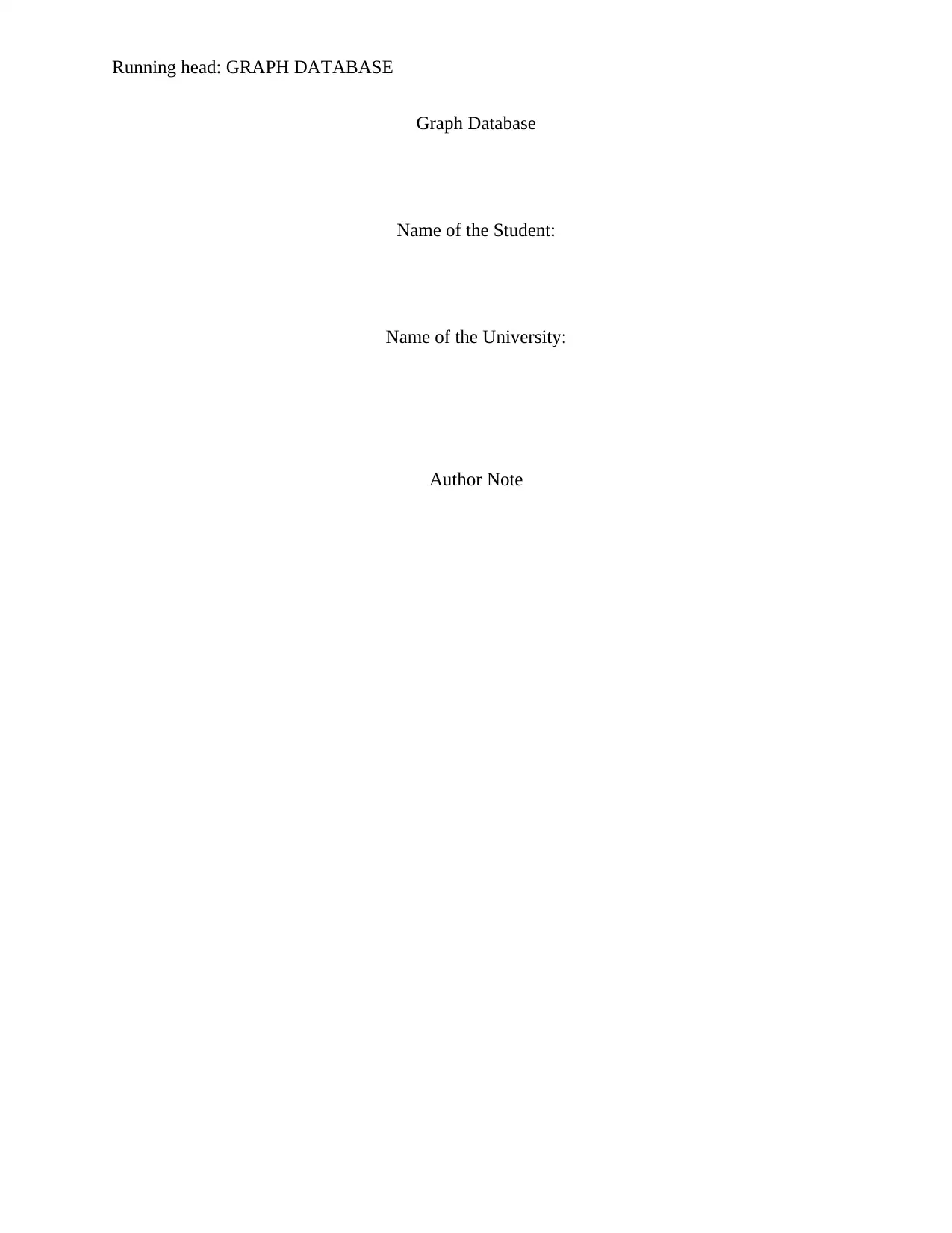
Running head: GRAPH DATABASE
Graph Database
Name of the Student:
Name of the University:
Author Note
Graph Database
Name of the Student:
Name of the University:
Author Note
Paraphrase This Document
Need a fresh take? Get an instant paraphrase of this document with our AI Paraphraser
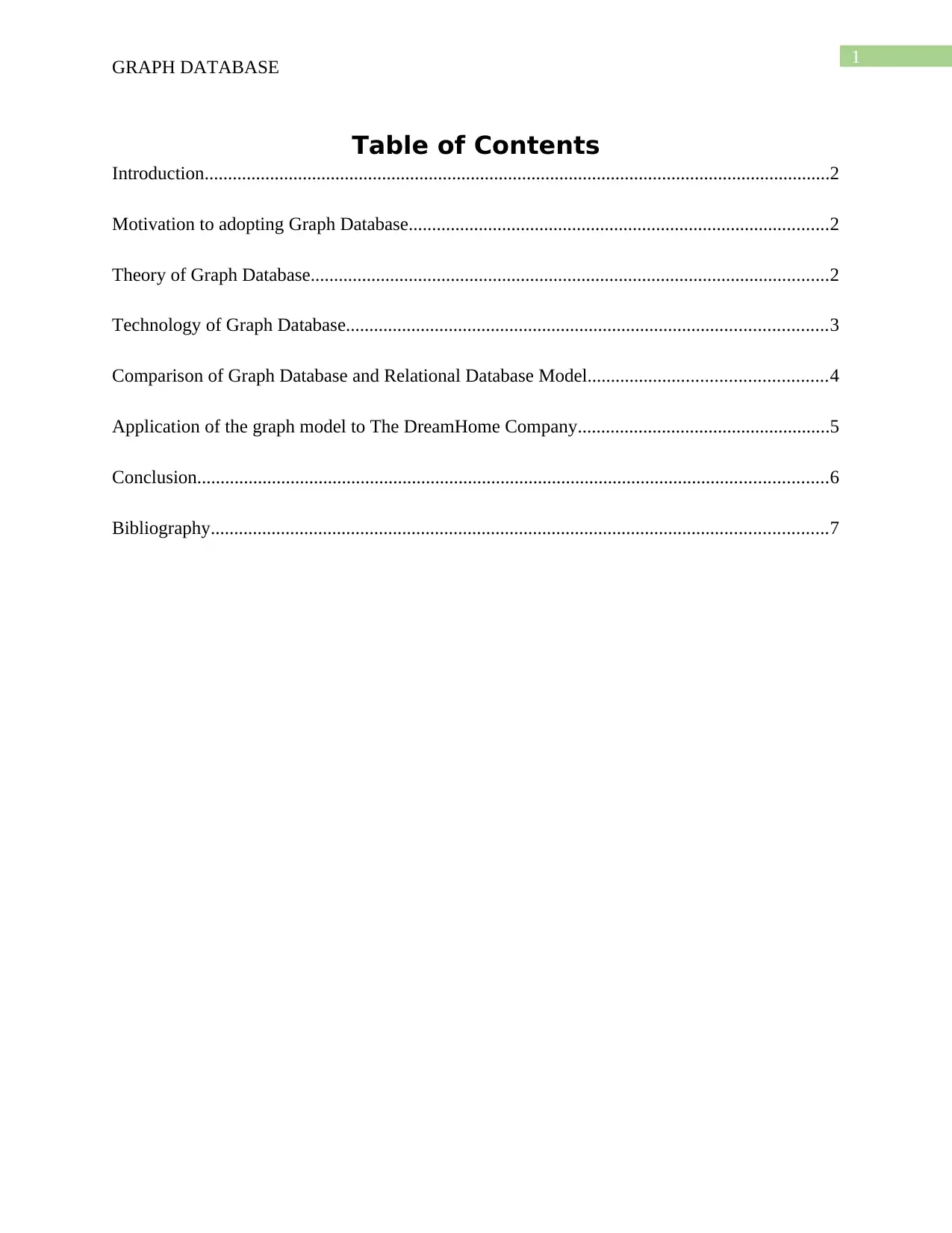
1
GRAPH DATABASE
Table of Contents
Introduction......................................................................................................................................2
Motivation to adopting Graph Database..........................................................................................2
Theory of Graph Database...............................................................................................................2
Technology of Graph Database.......................................................................................................3
Comparison of Graph Database and Relational Database Model...................................................4
Application of the graph model to The DreamHome Company......................................................5
Conclusion.......................................................................................................................................6
Bibliography....................................................................................................................................7
GRAPH DATABASE
Table of Contents
Introduction......................................................................................................................................2
Motivation to adopting Graph Database..........................................................................................2
Theory of Graph Database...............................................................................................................2
Technology of Graph Database.......................................................................................................3
Comparison of Graph Database and Relational Database Model...................................................4
Application of the graph model to The DreamHome Company......................................................5
Conclusion.......................................................................................................................................6
Bibliography....................................................................................................................................7
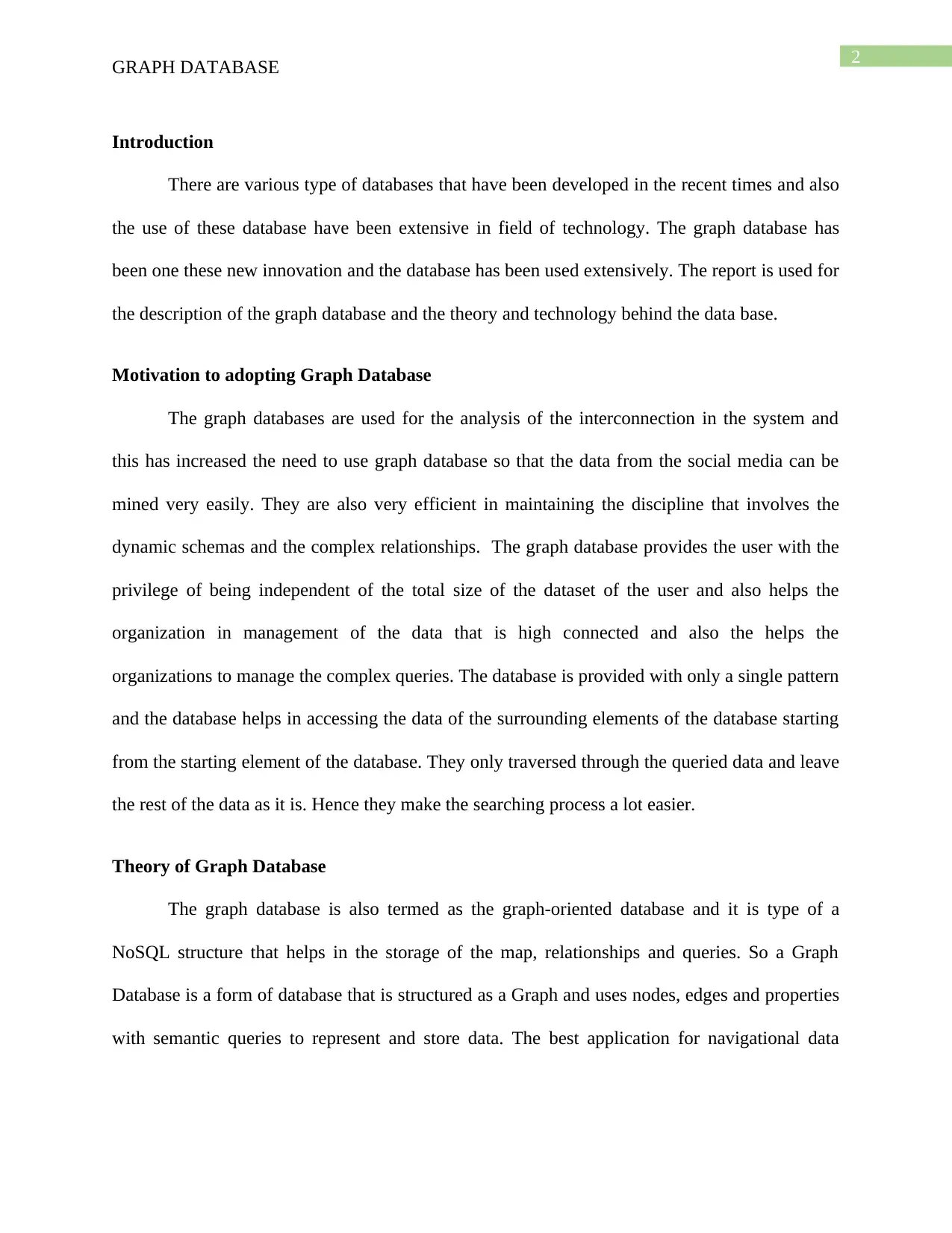
2
GRAPH DATABASE
Introduction
There are various type of databases that have been developed in the recent times and also
the use of these database have been extensive in field of technology. The graph database has
been one these new innovation and the database has been used extensively. The report is used for
the description of the graph database and the theory and technology behind the data base.
Motivation to adopting Graph Database
The graph databases are used for the analysis of the interconnection in the system and
this has increased the need to use graph database so that the data from the social media can be
mined very easily. They are also very efficient in maintaining the discipline that involves the
dynamic schemas and the complex relationships. The graph database provides the user with the
privilege of being independent of the total size of the dataset of the user and also helps the
organization in management of the data that is high connected and also the helps the
organizations to manage the complex queries. The database is provided with only a single pattern
and the database helps in accessing the data of the surrounding elements of the database starting
from the starting element of the database. They only traversed through the queried data and leave
the rest of the data as it is. Hence they make the searching process a lot easier.
Theory of Graph Database
The graph database is also termed as the graph-oriented database and it is type of a
NoSQL structure that helps in the storage of the map, relationships and queries. So a Graph
Database is a form of database that is structured as a Graph and uses nodes, edges and properties
with semantic queries to represent and store data. The best application for navigational data
GRAPH DATABASE
Introduction
There are various type of databases that have been developed in the recent times and also
the use of these database have been extensive in field of technology. The graph database has
been one these new innovation and the database has been used extensively. The report is used for
the description of the graph database and the theory and technology behind the data base.
Motivation to adopting Graph Database
The graph databases are used for the analysis of the interconnection in the system and
this has increased the need to use graph database so that the data from the social media can be
mined very easily. They are also very efficient in maintaining the discipline that involves the
dynamic schemas and the complex relationships. The graph database provides the user with the
privilege of being independent of the total size of the dataset of the user and also helps the
organization in management of the data that is high connected and also the helps the
organizations to manage the complex queries. The database is provided with only a single pattern
and the database helps in accessing the data of the surrounding elements of the database starting
from the starting element of the database. They only traversed through the queried data and leave
the rest of the data as it is. Hence they make the searching process a lot easier.
Theory of Graph Database
The graph database is also termed as the graph-oriented database and it is type of a
NoSQL structure that helps in the storage of the map, relationships and queries. So a Graph
Database is a form of database that is structured as a Graph and uses nodes, edges and properties
with semantic queries to represent and store data. The best application for navigational data
⊘ This is a preview!⊘
Do you want full access?
Subscribe today to unlock all pages.

Trusted by 1+ million students worldwide
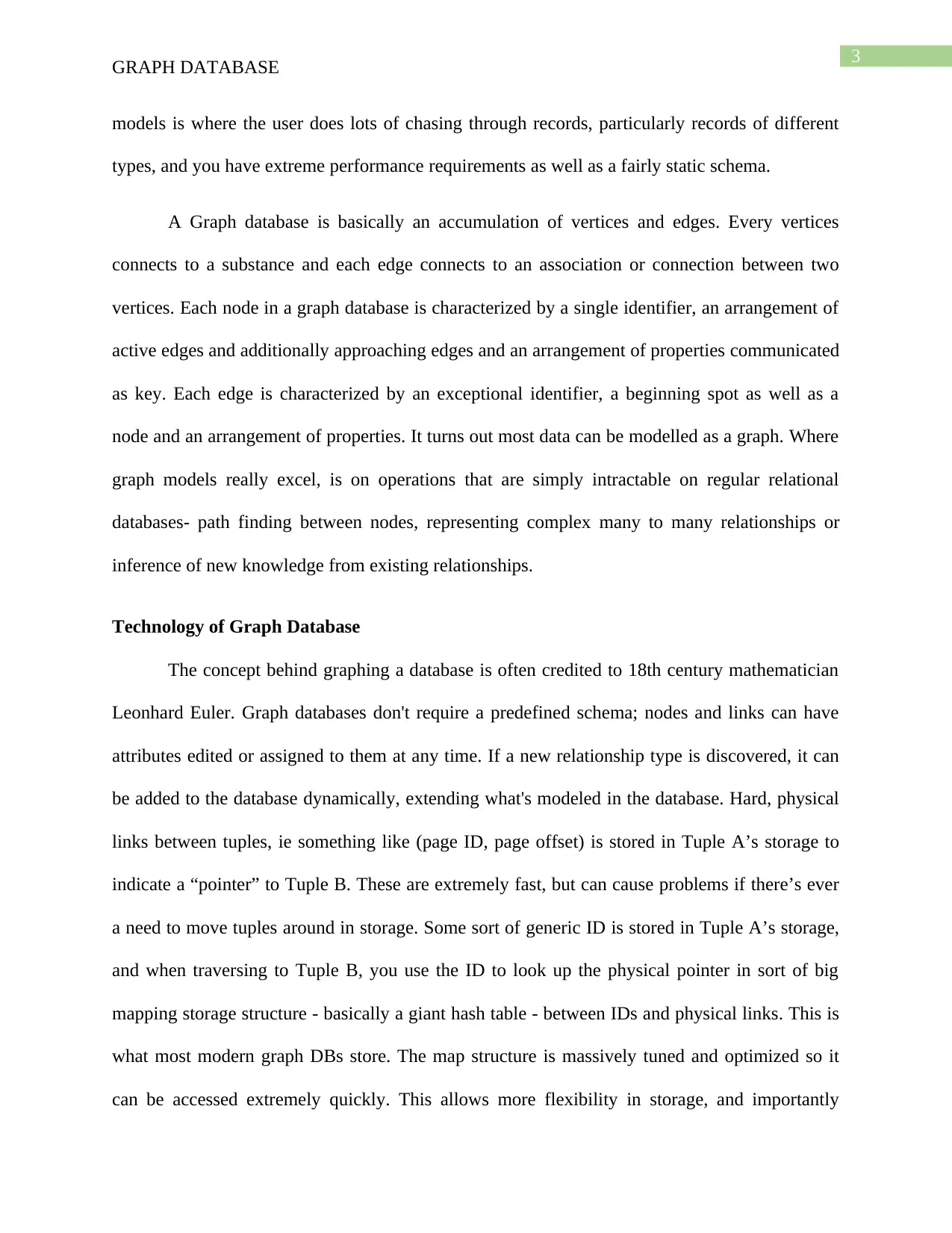
3
GRAPH DATABASE
models is where the user does lots of chasing through records, particularly records of different
types, and you have extreme performance requirements as well as a fairly static schema.
A Graph database is basically an accumulation of vertices and edges. Every vertices
connects to a substance and each edge connects to an association or connection between two
vertices. Each node in a graph database is characterized by a single identifier, an arrangement of
active edges and additionally approaching edges and an arrangement of properties communicated
as key. Each edge is characterized by an exceptional identifier, a beginning spot as well as a
node and an arrangement of properties. It turns out most data can be modelled as a graph. Where
graph models really excel, is on operations that are simply intractable on regular relational
databases- path finding between nodes, representing complex many to many relationships or
inference of new knowledge from existing relationships.
Technology of Graph Database
The concept behind graphing a database is often credited to 18th century mathematician
Leonhard Euler. Graph databases don't require a predefined schema; nodes and links can have
attributes edited or assigned to them at any time. If a new relationship type is discovered, it can
be added to the database dynamically, extending what's modeled in the database. Hard, physical
links between tuples, ie something like (page ID, page offset) is stored in Tuple A’s storage to
indicate a “pointer” to Tuple B. These are extremely fast, but can cause problems if there’s ever
a need to move tuples around in storage. Some sort of generic ID is stored in Tuple A’s storage,
and when traversing to Tuple B, you use the ID to look up the physical pointer in sort of big
mapping storage structure - basically a giant hash table - between IDs and physical links. This is
what most modern graph DBs store. The map structure is massively tuned and optimized so it
can be accessed extremely quickly. This allows more flexibility in storage, and importantly
GRAPH DATABASE
models is where the user does lots of chasing through records, particularly records of different
types, and you have extreme performance requirements as well as a fairly static schema.
A Graph database is basically an accumulation of vertices and edges. Every vertices
connects to a substance and each edge connects to an association or connection between two
vertices. Each node in a graph database is characterized by a single identifier, an arrangement of
active edges and additionally approaching edges and an arrangement of properties communicated
as key. Each edge is characterized by an exceptional identifier, a beginning spot as well as a
node and an arrangement of properties. It turns out most data can be modelled as a graph. Where
graph models really excel, is on operations that are simply intractable on regular relational
databases- path finding between nodes, representing complex many to many relationships or
inference of new knowledge from existing relationships.
Technology of Graph Database
The concept behind graphing a database is often credited to 18th century mathematician
Leonhard Euler. Graph databases don't require a predefined schema; nodes and links can have
attributes edited or assigned to them at any time. If a new relationship type is discovered, it can
be added to the database dynamically, extending what's modeled in the database. Hard, physical
links between tuples, ie something like (page ID, page offset) is stored in Tuple A’s storage to
indicate a “pointer” to Tuple B. These are extremely fast, but can cause problems if there’s ever
a need to move tuples around in storage. Some sort of generic ID is stored in Tuple A’s storage,
and when traversing to Tuple B, you use the ID to look up the physical pointer in sort of big
mapping storage structure - basically a giant hash table - between IDs and physical links. This is
what most modern graph DBs store. The map structure is massively tuned and optimized so it
can be accessed extremely quickly. This allows more flexibility in storage, and importantly
Paraphrase This Document
Need a fresh take? Get an instant paraphrase of this document with our AI Paraphraser
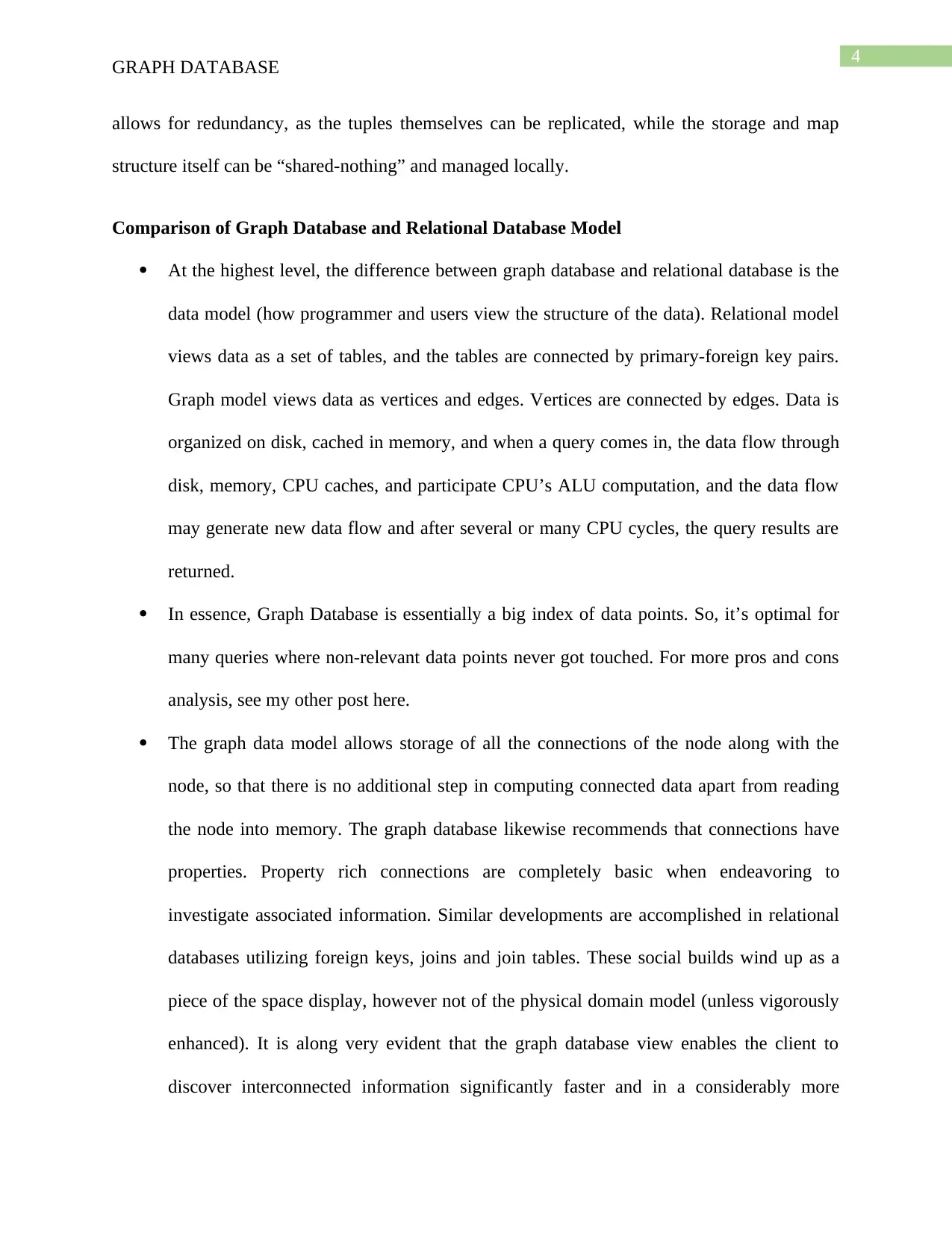
4
GRAPH DATABASE
allows for redundancy, as the tuples themselves can be replicated, while the storage and map
structure itself can be “shared-nothing” and managed locally.
Comparison of Graph Database and Relational Database Model
At the highest level, the difference between graph database and relational database is the
data model (how programmer and users view the structure of the data). Relational model
views data as a set of tables, and the tables are connected by primary-foreign key pairs.
Graph model views data as vertices and edges. Vertices are connected by edges. Data is
organized on disk, cached in memory, and when a query comes in, the data flow through
disk, memory, CPU caches, and participate CPU’s ALU computation, and the data flow
may generate new data flow and after several or many CPU cycles, the query results are
returned.
In essence, Graph Database is essentially a big index of data points. So, it’s optimal for
many queries where non-relevant data points never got touched. For more pros and cons
analysis, see my other post here.
The graph data model allows storage of all the connections of the node along with the
node, so that there is no additional step in computing connected data apart from reading
the node into memory. The graph database likewise recommends that connections have
properties. Property rich connections are completely basic when endeavoring to
investigate associated information. Similar developments are accomplished in relational
databases utilizing foreign keys, joins and join tables. These social builds wind up as a
piece of the space display, however not of the physical domain model (unless vigorously
enhanced). It is along very evident that the graph database view enables the client to
discover interconnected information significantly faster and in a considerably more
GRAPH DATABASE
allows for redundancy, as the tuples themselves can be replicated, while the storage and map
structure itself can be “shared-nothing” and managed locally.
Comparison of Graph Database and Relational Database Model
At the highest level, the difference between graph database and relational database is the
data model (how programmer and users view the structure of the data). Relational model
views data as a set of tables, and the tables are connected by primary-foreign key pairs.
Graph model views data as vertices and edges. Vertices are connected by edges. Data is
organized on disk, cached in memory, and when a query comes in, the data flow through
disk, memory, CPU caches, and participate CPU’s ALU computation, and the data flow
may generate new data flow and after several or many CPU cycles, the query results are
returned.
In essence, Graph Database is essentially a big index of data points. So, it’s optimal for
many queries where non-relevant data points never got touched. For more pros and cons
analysis, see my other post here.
The graph data model allows storage of all the connections of the node along with the
node, so that there is no additional step in computing connected data apart from reading
the node into memory. The graph database likewise recommends that connections have
properties. Property rich connections are completely basic when endeavoring to
investigate associated information. Similar developments are accomplished in relational
databases utilizing foreign keys, joins and join tables. These social builds wind up as a
piece of the space display, however not of the physical domain model (unless vigorously
enhanced). It is along very evident that the graph database view enables the client to
discover interconnected information significantly faster and in a considerably more

5
GRAPH DATABASE
versatile way when contrasted with the relational data model (push) addresses versus
falling joins on foreign keys. This is the reason why the graph data model should perform
much better than the relational data model in information retrieval - type recommendation
problems.
Some data is best thought of as a graph, and tables are a fairly unnatural way to represent
a graph. Should there be a vertex per row having a unique name and a payload of
information associated with the vertex along with a number of columns storing unique
name for a possible neighbor connected to the given vertex. That could give a neighbor
lookup operation in sub linear time if you have an index on vertex IDs, but something
like a B-tree index lookup is still O(log n) asymptotically and will require several I/O
instructions on computer architectures, whereas explicitly storing links in a graph data
structure gives i/O lookup asymptotically and can use just one I/O operation
Application of the graph model to The DreamHome Company
The DreamHome Company was opened in the year 1992 in the city of Glasgow in UK.
Since, the time there has been a Steady Growth for the company and hence, now there has been a
requirement of the company to handle a huge amount of paper work. Hence, there to many
mistakes in the paperwork. Therefore the company has realized that there is an urgent to
requirement to deploy a database for the company. The company works in the department of
property management and they have around 2000 staffs that work across 100 branches. They
also need to keep an account of the properties and the rent for each of the property. Additionally
there has to be a record for the customers and the payments made by the customers. According to
the director of the company, the databases requires to store all the details of the company and the
director should also be able to see the summary of the data that has been stored in the system.
GRAPH DATABASE
versatile way when contrasted with the relational data model (push) addresses versus
falling joins on foreign keys. This is the reason why the graph data model should perform
much better than the relational data model in information retrieval - type recommendation
problems.
Some data is best thought of as a graph, and tables are a fairly unnatural way to represent
a graph. Should there be a vertex per row having a unique name and a payload of
information associated with the vertex along with a number of columns storing unique
name for a possible neighbor connected to the given vertex. That could give a neighbor
lookup operation in sub linear time if you have an index on vertex IDs, but something
like a B-tree index lookup is still O(log n) asymptotically and will require several I/O
instructions on computer architectures, whereas explicitly storing links in a graph data
structure gives i/O lookup asymptotically and can use just one I/O operation
Application of the graph model to The DreamHome Company
The DreamHome Company was opened in the year 1992 in the city of Glasgow in UK.
Since, the time there has been a Steady Growth for the company and hence, now there has been a
requirement of the company to handle a huge amount of paper work. Hence, there to many
mistakes in the paperwork. Therefore the company has realized that there is an urgent to
requirement to deploy a database for the company. The company works in the department of
property management and they have around 2000 staffs that work across 100 branches. They
also need to keep an account of the properties and the rent for each of the property. Additionally
there has to be a record for the customers and the payments made by the customers. According to
the director of the company, the databases requires to store all the details of the company and the
director should also be able to see the summary of the data that has been stored in the system.
⊘ This is a preview!⊘
Do you want full access?
Subscribe today to unlock all pages.

Trusted by 1+ million students worldwide
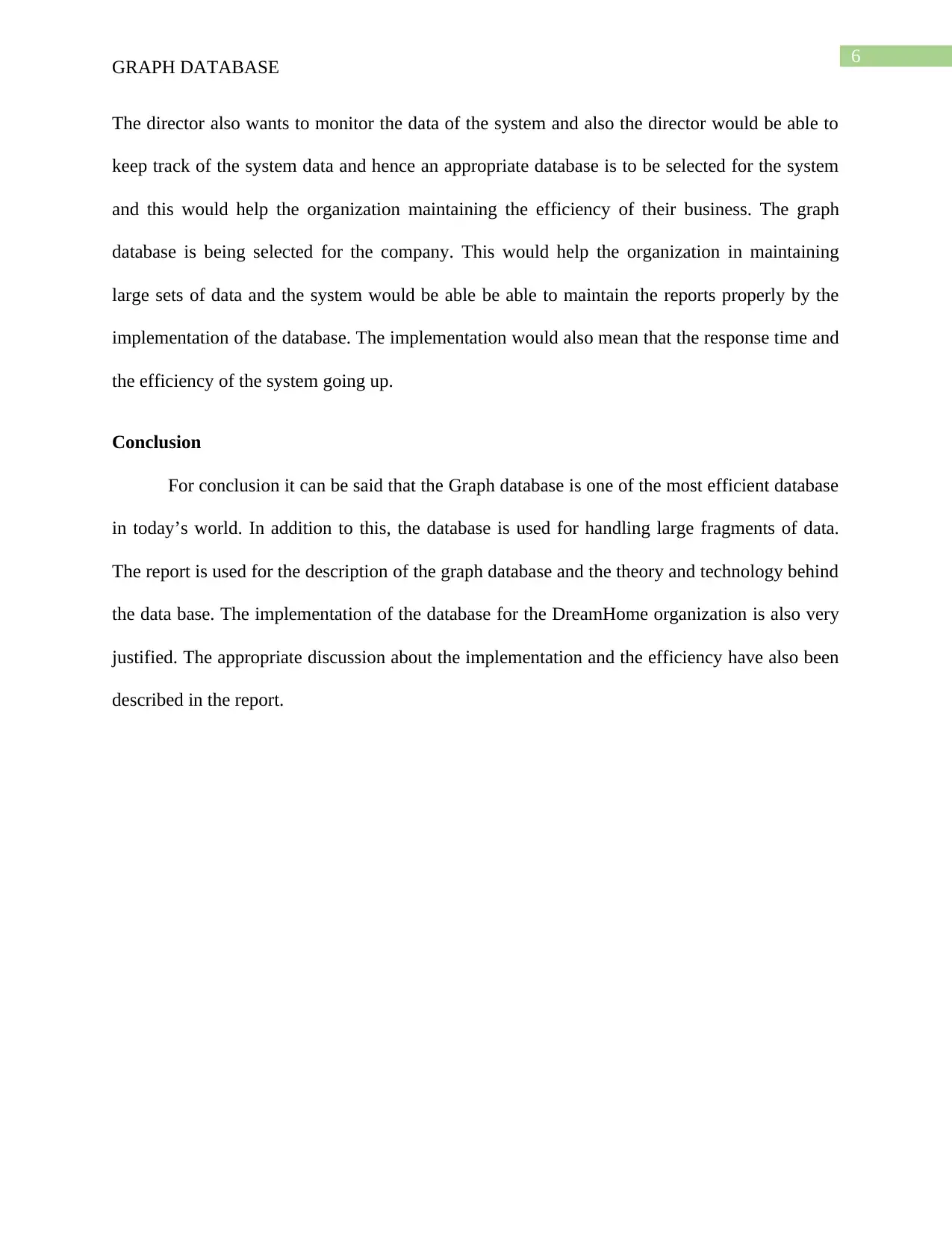
6
GRAPH DATABASE
The director also wants to monitor the data of the system and also the director would be able to
keep track of the system data and hence an appropriate database is to be selected for the system
and this would help the organization maintaining the efficiency of their business. The graph
database is being selected for the company. This would help the organization in maintaining
large sets of data and the system would be able be able to maintain the reports properly by the
implementation of the database. The implementation would also mean that the response time and
the efficiency of the system going up.
Conclusion
For conclusion it can be said that the Graph database is one of the most efficient database
in today’s world. In addition to this, the database is used for handling large fragments of data.
The report is used for the description of the graph database and the theory and technology behind
the data base. The implementation of the database for the DreamHome organization is also very
justified. The appropriate discussion about the implementation and the efficiency have also been
described in the report.
GRAPH DATABASE
The director also wants to monitor the data of the system and also the director would be able to
keep track of the system data and hence an appropriate database is to be selected for the system
and this would help the organization maintaining the efficiency of their business. The graph
database is being selected for the company. This would help the organization in maintaining
large sets of data and the system would be able be able to maintain the reports properly by the
implementation of the database. The implementation would also mean that the response time and
the efficiency of the system going up.
Conclusion
For conclusion it can be said that the Graph database is one of the most efficient database
in today’s world. In addition to this, the database is used for handling large fragments of data.
The report is used for the description of the graph database and the theory and technology behind
the data base. The implementation of the database for the DreamHome organization is also very
justified. The appropriate discussion about the implementation and the efficiency have also been
described in the report.
Paraphrase This Document
Need a fresh take? Get an instant paraphrase of this document with our AI Paraphraser
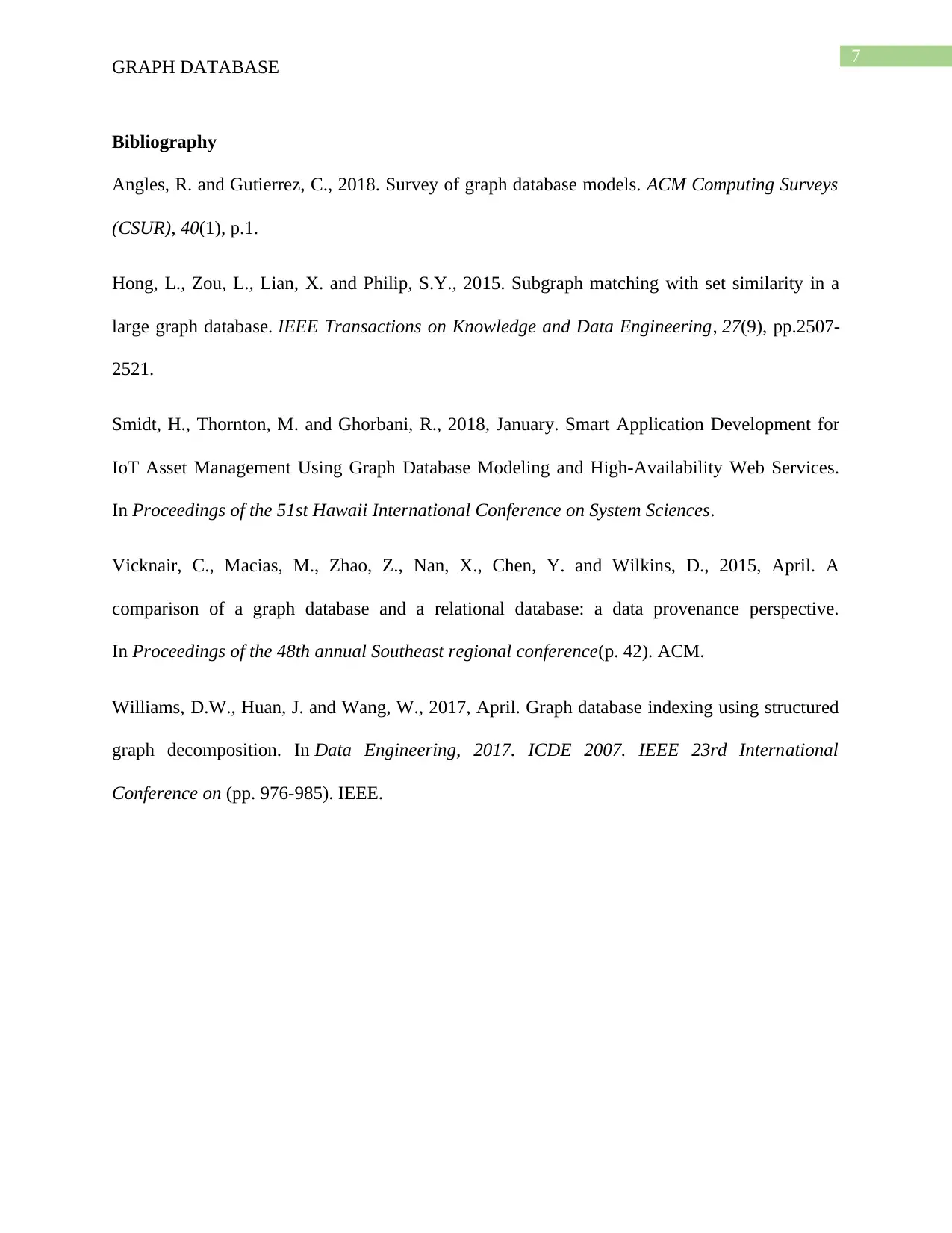
7
GRAPH DATABASE
Bibliography
Angles, R. and Gutierrez, C., 2018. Survey of graph database models. ACM Computing Surveys
(CSUR), 40(1), p.1.
Hong, L., Zou, L., Lian, X. and Philip, S.Y., 2015. Subgraph matching with set similarity in a
large graph database. IEEE Transactions on Knowledge and Data Engineering, 27(9), pp.2507-
2521.
Smidt, H., Thornton, M. and Ghorbani, R., 2018, January. Smart Application Development for
IoT Asset Management Using Graph Database Modeling and High-Availability Web Services.
In Proceedings of the 51st Hawaii International Conference on System Sciences.
Vicknair, C., Macias, M., Zhao, Z., Nan, X., Chen, Y. and Wilkins, D., 2015, April. A
comparison of a graph database and a relational database: a data provenance perspective.
In Proceedings of the 48th annual Southeast regional conference(p. 42). ACM.
Williams, D.W., Huan, J. and Wang, W., 2017, April. Graph database indexing using structured
graph decomposition. In Data Engineering, 2017. ICDE 2007. IEEE 23rd International
Conference on (pp. 976-985). IEEE.
GRAPH DATABASE
Bibliography
Angles, R. and Gutierrez, C., 2018. Survey of graph database models. ACM Computing Surveys
(CSUR), 40(1), p.1.
Hong, L., Zou, L., Lian, X. and Philip, S.Y., 2015. Subgraph matching with set similarity in a
large graph database. IEEE Transactions on Knowledge and Data Engineering, 27(9), pp.2507-
2521.
Smidt, H., Thornton, M. and Ghorbani, R., 2018, January. Smart Application Development for
IoT Asset Management Using Graph Database Modeling and High-Availability Web Services.
In Proceedings of the 51st Hawaii International Conference on System Sciences.
Vicknair, C., Macias, M., Zhao, Z., Nan, X., Chen, Y. and Wilkins, D., 2015, April. A
comparison of a graph database and a relational database: a data provenance perspective.
In Proceedings of the 48th annual Southeast regional conference(p. 42). ACM.
Williams, D.W., Huan, J. and Wang, W., 2017, April. Graph database indexing using structured
graph decomposition. In Data Engineering, 2017. ICDE 2007. IEEE 23rd International
Conference on (pp. 976-985). IEEE.
1 out of 8
Related Documents
Your All-in-One AI-Powered Toolkit for Academic Success.
+13062052269
info@desklib.com
Available 24*7 on WhatsApp / Email
![[object Object]](/_next/static/media/star-bottom.7253800d.svg)
Unlock your academic potential
Copyright © 2020–2026 A2Z Services. All Rights Reserved. Developed and managed by ZUCOL.





